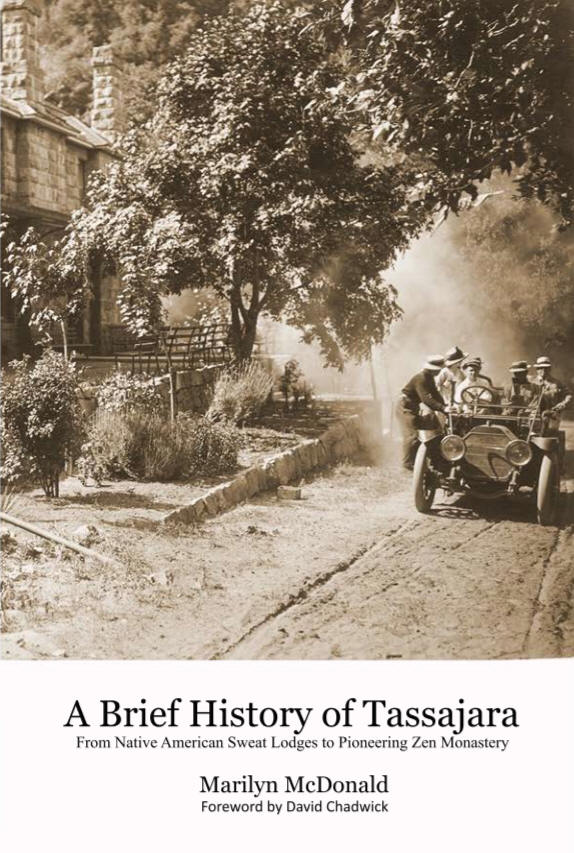|
I got to share some highlights of Marilyn’s progress the next year
when I was director. By then she knew more about Tassajara history
than anyone I knew except Jack. I admired her for sticking with it,
and felt we were kindred spirits in that I was focused then in my
free time on studying Zen writings and chants in the original. I saw
in Marilyn that same sort of drive and suggested that maybe we had
the research gene.
After that year I didn’t live at Tassajara but returned for short
stays in the summer and sometimes would be there when she was, her
store of knowledge about Tassajara’s past ever vaster. I lost track
of Marilyn but would think of her when I’d pick up the scrapbook
she’d left us with historical clippings, photos, and stories.
In the late 1980s I got into writing about my experiences in Japan
and Zen Center and about the life, teaching, and community of the
San Francisco Zen Center’s founder, Shunryu Suzuki. A few websites
grew out of that work. One, cuke.com, included interviews and
background. Early last year I decided to create a page for pre–Zen
Center Tassajara history to gather in one place what there was here
and there on the site and elsewhere within easy reach. I remembered
Marilyn and her work and decided to contact her. I sent a message to
Leslie James, a senior teacher in Zen Center, who along with her
husband Keith Meyerhoff has been living at Tassajara and Tassajara’s
way station at Jamesburg for many years. I learned then that Marilyn
had passed on just half a year prior and that there had been a
service for her at Tassajara. It was sad news to hear and I wished
I’d thought of contacting her much earlier.
I brought up with Leslie the possibility of getting Marilyn’s
material scanned and preserved better, something that I’d thought
about for years. I was relieved to learn that Marilyn’s friend Mark
Stromberg had just recently contacted Keith to discuss making
Marilyn’s scrapbook more widely available. Before long I was
corresponding with Mark and then Marilyn’s son Larry Burns. Each of
them sent me a
pdf
of slightly different versions of her book. Larry and his sister,
Lee Doyle, wrote a touching remembrance of Marilyn that now resides
on a page on cuke.com for her and this book
(www.cuke.com/tass-marilyn). In it they wrote:
She was, in many respects, while quite outgoing, a very private
person. She was a maverick in all things, refusing normalcy,
distrustful of the status quo. She loved gardens, but more so the
notion of a hidden courtyard with thick overgrown ivy on high walls
separating, as well as protecting her from the world at large. She
was an intensely loyal, family-centric person who raised five
children, two of her own and three from her second marriage.
From the mid-1970s through the early 1980s, she traveled to
Tassajara on weekends during the guest season—May to September.
While practicing Zen, she began writing the history of the Hot
Springs. She took to traveling widely in Monterey County at every
chance, interviewing anyone and everyone who’d been part of the
place, from the stagecoach drivers to the cooks. She documented
conversations and stories, collected boxes of pictures, and
passionately began writing an important part of California history
with the skill of a scholar.
Now I find myself back again with Marilyn in the intriguing
narrative of this book. I imagine times when there were grizzly
bears, trappers, a creek full of fish, a narrow trail leading in
just wide enough for a horse, the labor intensive building of the
road, the early guests camping out in tents, the twelve hour trip in
on the horse drawn stage from Salinas, the early cars, the bootleg
whiskey guests would sneak in, the outdoor dance platform, the great
old sandstone hotel, and the most evocative—contemplating the
unknown thousands of years the Esselen and other Native Americans
came for the sacred waters and purifying steam in sweat lodges.
Marilyn had a clear eye and tells this story as it was told to her
by people and news clippings—without any romanticizing or
unnecessary elaboration. She did a good job on the final brief Zen
Center section. I was at Tassajara from a few months after it was
purchased and can vouch for most of what she wrote. I also checked
things out with others including Tassajara’s first head monk and
Suzuki’s virtual co-founder of the place, Richard Baker, the
director for the first few years Peter Schneider, the first head
cook Edward Brown who had worked in the kitchen there the year
before Zen Center acquired it, Alan Yehudah Winter who was there
very early on, and Leslie James for the later years. I found that
people were delighted to be reminded of those early Zen days at
Tassajara.
A meal chant used by practitioners at Tassajara has this line:
“Seventy-two labors brought us this rice. We should know how it
comes to us.” Many labors likewise brought us Tassajara in unspoiled
condition after being tended for millennia by Native Americans and
for a century by immigrant stock. In Buddhism, caring for the
physical space one inhabits is an integral part of the practice.
Shunryu Suzuki said, “Cleaning is first. Zazen (meditation) is
second.” This book reminds us that while we may have brought a new
spiritual lineage into that valley, it met there the ancient spirit
of the place and the people who came before.
David Chadwick |
 During
During